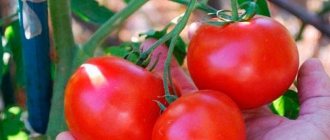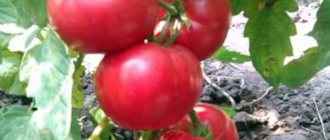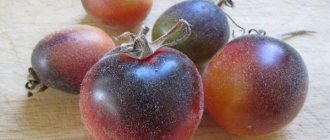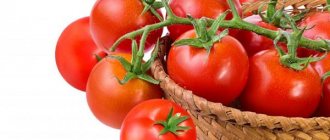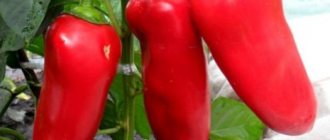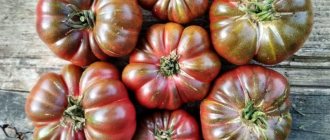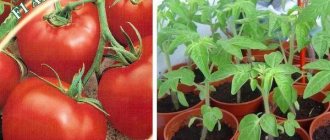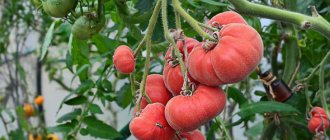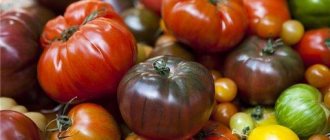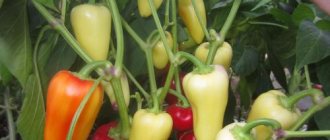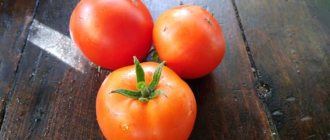The medicinal properties of the Duckling tomato became known only a few years ago. The vegetable is rich in minerals necessary for the normal functioning of the body, is actively used in dietary nutrition, and effectively resists the development of cancer.
In addition to its benefits, Duckling is also extremely tasty. The sweetish fruits are suitable for juice, preservation and fresh consumption. Where and how to properly grow a “home healer”, what features the variety has, read our article.
Characteristics and description of the variety
The duckling was bred by Russian breeders and entered into the State Register as a variety intended for cultivation in open ground, greenhouses and greenhouses. These tomatoes are not picky about temperature and can grow even in regions with cold climates.
The shape of the fruit is oval with a small nose. From a distance, the outline of the tomato resembles a heart-shaped shape. The average weight of one vegetable is 60-90 g. Tomatoes are well preserved during transportation even over long distances, without losing their presentation. Tomatoes also store well for a long time.
The only disadvantage of the variety is its low yield. From 1 sq. m, no more than 2-3 kg of fruits are collected.
Distinctive features
The low-growing bush has a standard form. The plant reaches 60-70 cm in height. When grown in a greenhouse or under a film cover, some bushes grow up to 1 m. There are few leaves on the plant, they have a rich green color. The plants do not need staking or shaping.
The variety has stable immunity to late blight and other diseases to which tomatoes are exposed. To raise a Duckling, choose highly fertile soil.
Features of agricultural technology
Tomatoes are grown not only in open beds, but also using temporary film shelters. It is also possible to plant seedlings in stationary greenhouses. Tomato bushes are very compact, so it is recommended to place them in the amount of 6 pieces per square meter. m. Plants do not need to be tied up or pinched. Seedling care is standard.
Attention! Unlike other varieties, these tomatoes love moisture very much, so special attention should be paid to watering.
When planting tomatoes in greenhouses, shedding of the ovaries is often observed, which often depends on:
- lack of moisture;
- non-compliance with the ventilation regime;
- plant nutritional disorders.
How to grow seedlings
To grow seedlings, seeds are sown in March-April. Grains are planted in open ground in May-June. Direct sowing is possible when the soil warms up to at least 15 degrees.
Seed preparation
If the packaging with seed material does not indicate that the treatment has already been carried out, the grains are disinfected independently. To do this, they are placed in a 1% solution of potassium permanganate and kept there for no more than 30 minutes; then rinse with clean water and lightly dry.
On a note! For easy removal from the solution, the seeds are wrapped in gauze before soaking.
If the planting material has already been disinfected by the manufacturer, it is simply kept under running clean water at room temperature, since swollen seeds germinate better.
In order for the seedlings to germinate quickly, the grains are pre-germinated. To do this, they are wrapped in dampened cotton cloth, gauze or paper napkin, placed in a plastic bag and placed on the battery. The seeds are periodically checked and, if necessary, moistened to prevent them from drying out.
When the seeds hatch (usually it takes 3-5 days), they begin sowing. Those that do not sprout are discarded because they are hollow.
Container and soil
Cups or tablets made of sphagnum peat are the most popular container for growing tomato seedlings (sphagnum acts as a reliable protection for the roots from rotting). When transplanting, tomato seedlings are placed in a prepared hole in an open bed along with a peat glass.
They also use containers made by themselves. The most suitable ones are plastic glasses or cut plastic bottles. They also cut cardboard juice boxes to the required level, and use packaging for dairy products. The optimal volume of the available container is 0.5 liters, this allows you to avoid diving the seedlings. If 100 ml cups are used, the seedlings are grown until 2-3 true leaves appear.
In homemade containers, drainage holes are made at the bottom so that excess liquid does not accumulate after watering.
For your information. When the seedlings are transplanted to a permanent place of growth, they are taken out of a plastic cup along with the soil.
Sowing
Sow seeds to obtain seedlings in late March - early April. The grains are buried to a depth of 1.5-2 cm. Then the container is covered with film or glass and left in this form until the first shoots appear. After this, the seedlings are transferred to the brightest windowsill or illuminated using phytolamps.
Important! Even the slightest drafts can destroy young shoots, as the soil in the containers quickly cools.
Growing and care
Seedlings should not be over-watered. Even if the top layer of soil has dried out, the soil inside the container remains moist for some time. If the sun is shining brightly, the seedlings should also not be over-watered. This is because by the evening the sun will hide, and the young plants will remain in the cold and moisture all night. The seedlings are watered for the first time about a week after sowing.
Important! Young plants should be watered only with settled and warm water.
When the first 2-3 true leaves appear on the sprout, a dive is performed. The tomatoes are transplanted into a separate, larger container. This way the plants will get stronger and gain strength faster.
The first fertilizer is applied 2-3 weeks after the sprouts appear, and subsequent fertilizers are applied every seven days.
For fertilizer mix:
- 3 g potassium sulfate;
- 1 g urea;
- 8 g superphosphate;
- 2 liters of water.
You can also prepare a yeast infusion at home:
- 5 g of bread yeast are diluted in 5 liters of water;
- stir thoroughly;
- insist for 24 hours.
Yeast solution cannot be stored. It is used immediately after preparation.
An ash infusion is also prepared as a top dressing:
- 1 tbsp. spoon of wood ash;
- 2 liters of water.
The solution is mixed well and allowed to brew for 24 hours, after which it is filtered.
For your information. An alternative option is peat tablets, in which seeds are planted for seedlings instead of artificial containers. They enrich the soil with nutrients and provide additional breathability of the soil, which has a positive effect on the formation of the root system.
With proper care of seedlings, by the end of the second week the plants become strong, stocky and acquire a bright green color.
Plant characteristics
Tomato Duckling is considered a medicinal variety.
It is recommended by the State Register of the Russian Federation for planting in open ground and under film shelters. This variety is used for dietary nutrition and for the prevention of cancer. Tomatoes have a sweetish taste. Characteristics and description of the variety:
- The plant is distinguished by early fruit ripening.
- From the appearance of seedlings to the ripening of the harvest, about 102-107 days pass.
- Plants of this variety are standard, determinate type.
- Tomato bushes of the Utenok variety grow up to 55-70 cm in an open garden bed.
- In greenhouses the plant reaches a height of 90-100 cm.
- Tomatoes have an average number of leaves.
- The leaves are dark green.
- The tomato is resistant to various diseases and root rot.
- Even with sudden temperature changes and bad weather, the plant forms clusters with ovaries.
- The Utenok variety does not require tying the bush to supports or pinching.
Let's consider the advantages and disadvantages of the variety.
The advantages are as follows:
- the bushes are small in size,
- the harvest ripens at the same time,
- fruits are used to prevent cancer,
- excellent taste of fruits,
- disease resistance,
- unpretentiousness in care,
- resistance to temperature changes.
Among the shortcomings, one can highlight only not too high yield.
Duckling tomatoes have a round shape with a characteristic spout. The color of the fruit varies from yellow to orange. The weight of tomatoes is 60-80 g. Every housewife who has planted this variety notes that tomatoes are universal in use.
Many people write: I grow tomatoes to make salads, juices, sauces, gravies, side dishes for hot meat dishes and cold appetizers. The fruits can also be salted and pickled.
The yield of this variety is relatively low. From 1 m² you can collect from 2 to 2.4 kg of fruit. Tomatoes are characterized by excellent presentation and good transportability. Due to the thickness of the skin of tomatoes, they can be stored for a long time in boxes in a cool, dry room. When stored for a long time, tomatoes do not crack.
Let's look at how to grow a rich harvest of tomatoes. This variety should be grown in seedlings with sprouts being picked into separate containers. Sowing seeds for seedlings should be done at the end of March or beginning of April. After the first leaves appear, you need to pick the seedlings into separate containers, for example, into peat pots.
The Duckling is planted in open ground in early June. After planting, during further cultivation of plants, the bushes are fertilized twice. To produce more fruits, tomatoes are treated with a growth stimulator. When growing plants, you need to regularly water, weed, and loosen the soil in a timely manner.
In some cases, in tomatoes in a greenhouse, the ovary sheds. This can be caused by a lack of humidity, poor nutrition of the bushes, diseases, or disruption of the air regime. The greenhouse must be ventilated regularly. During the formation of the ovary and ripening of the fruits, special attention should be paid to watering the plants. Watering should be regular, it should be done at the same time, with warm water.
When watering, approximately 15 liters of water should be used per 1 m². Depending on the weather, you need to adjust the volume of water. If plant flowers fall off during warming, this indicates a lack of phosphorus and nitrogen. Then the plants need to be fertilized with fertilizers containing these substances.
If the ovaries fall off before harvest, this indicates infection with blossom end rot. This variety is resistant to this disease. But for prevention purposes, plants should be treated with boric acid.
If there is not enough air in the greenhouse or it is poorly ventilated, the humidity in the room increases. In such conditions, flowers are poorly pollinated, and therefore the plant sheds such ovaries. In this case, it is necessary to establish a ventilation regime for the greenhouse.
Reviews from gardeners about the Duckling tomato are mostly positive. Such tomatoes are used fresh and various dishes are prepared from them; Tomatoes canned in jars have a beautiful orange color and excellent taste.
The bushes of the plant have a standard shape, are of a low-growing type and grow in height up to 55-70 cm. If the crop was grown in a greenhouse, then under more acceptable temperature conditions the crop can reach a height of 1 meter. There are not many leaves on the plant, and they are dark green in color. Thanks to this, the bush does not need to be tied up or pinched. The culture is characterized by simple inflorescences.
In addition, the plant is not picky about temperature, and grows well in areas with a cool climate. Tomato can be planted both in an open area and in a greenhouse. The advantage is resistance to late blight. Culture belongs to the determinant type. To grow the plant, you must choose highly fertile soil.
The tomato has good immunity and is rarely exposed to various diseases.
The fruits of “Flyash” tomatoes have an elongated pepper-shaped shape and reach a weight of 60 grams.
The fruits of the “Flash” tomato are small, weighing only 30 to 60 g, elongated, finger-shaped, vaguely reminiscent of a bottle.
- The bush is indeterminate, tall, grows up to 1.8 m, but is not too strong, so it requires high-quality garter.
- It produces few leaves; a large number of fruits are formed on long clusters.
- The color of tomatoes is bright red, they are very juicy, sweet and tasty, with a high content of dry matter.
- The fruit produces a minimal amount of seeds.
Tomato "Torch" is a prolific variety. The first inflorescence is formed after the 7th permanent leaf. Forms clusters with 5-7 fruits. Tomato "Torch" of medium ripening period. The fruits ripen on the 115th day from planting. Tomatoes are round, red, weighing up to 100 grams. From one square meter you can harvest up to 10 kg of crop.
Tomato fruits are fleshy, juicy, with a small amount of seeds. They have excellent taste. Well suited for pickling and canning.
How to grow tomatoes
Proper cultivation of the Duckling tomato involves timely watering, loosening the soil and regularly weeding the beds to remove small weeds. The crop has good resistance to most diseases, but it is better to play it safe and treat the soil with a weak solution of potassium permanganate.
Landing
Plants are transplanted to a permanent place of growth in mid-June.
For full growth and fruiting, the following substances must be present in the soil:
- nitrogen;
- potassium;
- phosphorus.
Important! The crop is planted in open ground according to a 40x60 cm pattern.
Care
Tomatoes are fertilized at least three times:
- The first fertilizer is applied two weeks after planting the plant in its permanent place. For this, mullein or bird droppings are used (700 g per 10 liters of water). They also use purchased ready-made preparations “Gumisol” or “Vermisil”.
- When flowers appear on the second cluster, fertilizing is applied a second time. Tomatoes are fertilized with a superphosphate solution (a glass per bucket of water).
- The third feeding is carried out when the first fruits begin to ripen. Apply a solution of mullein with the addition of complex fertilizer (75 g per bucket). At least 2 liters of solution is poured under each bush.
Tomatoes are watered every 3-4 days. In dry weather, the crop is moistened more often. The recommended watering rate is approximately 15 liters per 1 square meter. meter.
After moistening the soil, when the water is well absorbed, loosening is carried out and weeds are removed at the same time. Since an adult plant grows small, it does not need a garter. Also, culture does not need to be formed.
Important! To ensure that the bush is well ventilated and receives the maximum amount of sunlight, pinching is carried out once a week.
Features of cultivation and possible difficulties
Although the plant has strong immunity, some difficulties when growing tomatoes cannot be ruled out. Each vegetable grower plants a crop in his own way; the soil structure is different everywhere, which leads to certain problems.
When a plant's flowers and ovaries fall off, this means the bushes are running out of food and moisture. If tomatoes grow in a greenhouse, the cause is sometimes a lack of ventilation or fruit rot. To eliminate the problem, carry out regular watering with water at room temperature. Depending on weather conditions, the amount of watering must be adjusted.
If flowers and ovaries fall off due to rot on the top of the bush, then control the ventilation and systematic watering.
Diseases and pests
The Utenok variety is resistant to diseases that are characteristic of tomatoes, as well as fusarium, late blight, blossom end and root rot. For prevention purposes, the bushes are treated with a solution of boric acid.
The following pests are dangerous for tomatoes:
- spider mite;
- thrips;
- slugs;
- Colorado beetle.
Chemicals destroy pests immediately after spraying the bushes, but with this treatment the fruits cannot be eaten for a long time - from 10 to 21 days.
Biological products act more slowly, the death of insects and larvae occurs 3-5 days after spraying. But vegetables can be eaten 5-7 days after processing.
You can also get rid of pests using folk remedies:
- To eliminate insects, use a soap-ash solution. It is prepared from 1 kg of product and 10 liters of water. First, the ash is boiled for 15 minutes, then it is allowed to brew for two days and filtered. Dilute the resulting solution in another 10 liters of water. As an “adhesive”, add 50 g of soap per 10 liters of solution.
- Garlic infusion is effective. Add 200 g of crushed garlic or onion to 10 liters of water and let it brew for a day. The strong, pungent odor repels pests.
Tomato Duckling
Description and characteristics of the tomato variety Duckling, reviews, photos
An early-ripening, defining, low-growing, high-yielding variety of tomatoes for open umbrellas and foil umbrellas.
A perforated shrub, 40-60 cm high, does not require punctuation. The leaf is medium sized, green to dark green. The inflorescence is simple.
Basic qualities of fruits
The fruits are round with a 'spout', smooth, shiny, medium density, orange when ripe, 50-60 grams (up to 90 g), excellent taste (for early varieties). Not prone to cracking. These tomatoes are suitable for both fresh consumption and canning of whole fruits. Recommended for children's and dietary nutrition.
Advantages of the variety : early and friendly ripening of fruits, resistance to major tomato diseases. Good fruit placement even in unfavorable weather conditions.
Productivity : up to 1.5 kg of fruits per plant.
Tomato duck is registered in the State Register of the Russian Federation for cultivation in open ground and under foil on private farms.
Originator : Kozak V.I.
Features of growing tomatoes Duckling, planting and care
Seeds are sown on seedlings 50-55 days before the intended planting in the ground. The seedling appears at the stage of two true leaves. When planting seedlings in a stationary place, 1 sq.m. It is recommended to plant up to 6 plants.
Planting pattern : 50 x 40 cm, planting density: up to 6 plants per 1 square meter.
Further care for tomatoes consists of timely watering, fertilization with complex mineral fertilizers and preventive measures to protect plants from diseases and pests.
If you have grown duck tomatoes, please write whether you liked them or not. What was the yield and taste of fruits like in your climate? How do you rate the disease resistance of this variety? If possible, add photos of the entire bush or individual fruits that you grew to your comment. Thank you very much!
Your reviews of Ententomate and additions to the description will help many gardeners objectively judge this variety and decide whether to plant it or not.
This is a natural variety of tomatoes. Therefore, we recommend taking seeds from ripe fruits and using them for planting in the following seasons
Best reviews from our readers
- I have been planting for many years. Always with the harvest. By the way, Phytofluoro has no effect even in our region
- Very tasty beautiful tomato, in salty beauty. Planted outdoors without foil and in the cold summer of 2021, without this variety it would have been left without tomatoes, and so 'Duckling' fixed everything. I will definitely plant him!!!
- A few years ago I accidentally came across a bag of duck seeds. These are now our favorite tomatoes. I collect my tomato seeds because I can't find them in stores anymore. I like both fresh and salty. And they also have easily recognizable shrubs and fruits, not to be confused with other varieties
- Every year I plant a duck. I'm very pleased with the amount of tomatoes. And they are amazing! They are also delicious when cured. I collect my seeds. This is not a hybrid.
TomatLand12 165 views8 comments
Harvesting and application
The harvest is harvested in July-August. Duckling tomatoes are a unique variety of tomatoes that are known for their beneficial qualities. Dietary food is made from the fruits; they are suitable for consumption by diabetics. Tomatoes are used to prevent cancer.
In cooking, tomatoes are used to prepare various snacks, salads, and added to first courses. The fruits are suitable for canning and pickling in their entirety. Tomatoes are also used to make delicious, healthy juice.
Advantages and disadvantages of the variety
After repeatedly growing the Duckling tomato, vegetable growers identified the following advantages:
- the variety has strong immunity and is resistant to rotting of the upper and lower parts of the plant;
- the crop ripens in approximately one period;
- early ripening tomatoes;
- the bushes are compact, which simplifies care;
- tomatoes have medicinal properties;
- the bushes do not need shaping, staking or pinching.
Culture has virtually no downsides. The only negative feature is that the variety does not produce a bountiful harvest.
Fruit characteristics
Tomatoes have the following description. The fruit is round in shape and has a spout at the end. When viewed from a distance, the shape resembles a heart. The average weight of this tomato is 60-85 grams. The fruits are convenient to use both fresh for salads and for canning. The unique yellow color of the tomato will decorate your table.
In addition, they are not picky about transportation and can be transported over long distances. In this case, the fruit will not be wrinkled and will have its original appearance. Therefore, the fruits of this variety are characterized by good keeping quality. On average, a tomato can last more than 1 month without losing its taste and presentation.
Timely watering in sufficient quantities, application of fertilizers and biostimulants containing calcium are necessary. In this case, chemicals are used 50-60 days before the first harvest.
Regular loosening of the soil improves breathability and regulates humidity. Removing weeds also increases yield.
Tomatoes of this variety are oval in shape with a small spout on the edge. From afar they brush off a heart with something. The average weight of the fruit is 60-85 g. It is used both for fresh consumption and for pickling whole. The fruits are perfectly transported even over long distances, without losing their external characteristics. Also, tomatoes of this variety are perfectly stored.
Once you see the incomparable clusters of Flyashen tomatoes with a huge number of fruits, you will definitely want to grow such a miracle in your own garden.
The shape of tomatoes, as already described above, is elongated, oblong. They look like small bottles. Some gardeners call these tomatoes finger tomatoes, others call them icicle tomatoes. Indeed, tomatoes of this variety often develop a small spout at the end. But, since the original hybrid has, on the contrary, a small depression in this place, some plants can also produce fruits of this shape, that is, without a spout. This may be due to the fact that the variety has not yet completely stabilized.
The size of the tomatoes is small, you can even call them large cherry tomatoes. The average weight of the fruit is 40-60 cm, the length can reach 6-9 cm. Tomatoes ripen in clusters of such large size that they often resemble some kind of strange fruit, and not tomatoes at all. Up to several dozen fruits can ripen simultaneously in one cluster. The brushes themselves are also characterized by sufficient density, which only enhances the decorative effect of tomato bushes.
About
Farmer reviews
Gardeners respond mostly positively to the Duckling tomato. Let's consider some of the opinions of gardeners.
Natalya Malinovskaya: “I planted this tomato for the first time in 2010.
I cultivated it in open ground. The plant was covered with film. During the day I opened the bushes. One day in mid-May, on a cold night, my greenhouse opened due to the wind, and some bushes froze. But despite this, the plant produced stepsons and pleased with fruiting. In general, I liked the Duckling variety.” Olga Mitkevich: “I have been growing this variety for five years in a row. I plant a lot of bushes at once. Plants feel great in open ground. The fruits are stored well. Tomatoes look very beautiful in the garden, just like in the photo. I make preserves from them and prepare salads.”
Ekaterina Ivanova: “I’ll say right away about this variety that growing these tomatoes is not difficult. We have many who grow them. Tomatoes have proven themselves to be excellent. My children love to eat them, and most importantly, tomatoes are healthy. I also liked how they looked in the jar. I treat my relatives with canned food. Everyone likes it, everyone praises me, I will continue to grow them.”
Possible problems
Despite all the positive characteristics, some difficulties may arise when growing this variety. This is because each gardener has his own way of planting plants, as well as each plot has its own soil composition.
One of these problems may be shedding of color and ovary. When grown in a greenhouse, this may be due to lack of ventilation.
To eliminate this reason, you should open the doors and windows in the greenhouse immediately after watering.
To summarize, we can say the following: this variety has proven itself well and therefore has become very famous among gardeners. Children really like the fruits, and thanks to their yellow color, they look great in a jar in winter.
Despite the fact that the Duckling tomato has many positive characteristics, gardeners may encounter some difficulties when growing it. This is because growing conditions are different everywhere.
One of the problems is that flowers and ovaries of plants may fall off. If tomatoes are grown in a greenhouse, then this problem may be due to insufficient ventilation. To eliminate the problem, you need to open the doors and windows in the greenhouse after watering.
The variety practically does not suffer from tomato diseases, but for prevention, plants can be treated against late blight, the most common disease.
As a result, we can say that this variety has proven itself well, and therefore has become quite popular among gardeners. Because of their taste and beautiful yellow color, these tomatoes are a favorite among children, and they also look great in jars in winter. Duckling took all the best from good varieties of tomatoes for the greenhouse, and reviews of the variety confirm this.
